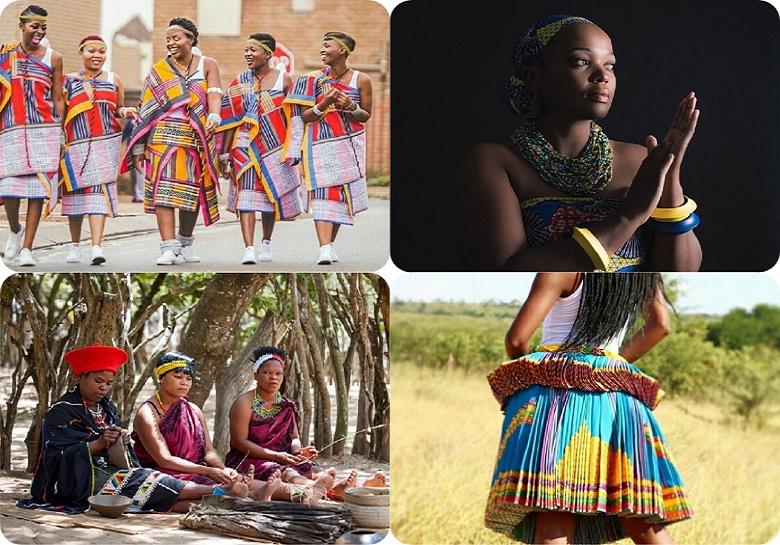Each clothing item that people choose to wear may be within their reach or used to express style and political, religious beliefs and perspective in life. Irrespective of how it was decided, each content of clothing contains a long history.
South Africa is located on Africa’s southern part, with coastlines in both the Atlantic and Indian Oceans. South Africa, Africa’s third-largest economy after Nigeria and Egypt, attracts hundreds of thousands of visitors each year, eager to see its spectacular landscape, wildlife, and cultural diversity.
The country’s diversity of cultures, racial groups, and religions has resulted in various traditional costumes. In African cultures, age and gender, for example, are a reflection of the clothes a person wears.
Different kinds of traditional clothing found in South African ethnic groups
Zulu traditional clothing
In Zulu culture, women also wear different clothes at various stages of their lives. A single young woman wears short hair and only a short grass reed – skirt decorated with beads, engaged women cover their breasts and grow their hair, and a married woman covers her entire body to show what is in evidence for her. She wears a thick cowhide skirt softened with animal fat and charcoal.
Traditionally, women covered their breasts with a cloth. Still, they wear cotton vests or beaded bras along with beaded necklaces these days. The round hat is the most symbolic piece of jewellery, called Izicolo; this hat is made of grass cotton and reached a meter across to protect the wearer from the sun.
The men traditionally wear animal skins and feathers. Because the Zulu revere leopards as kings of all predators, only royalty are permitted to wear leopard skins. A front apron (Isinene) and a back apron (Ibheshu) worn to cover the genitals and buttocks. Bundles of cow’s tail, called Amashoba, are worn on the shoulders and below the knees to give the appearance of greater bulk. The headbands are worn only by married men.
Venda traditional wear
Venda girls traditionally wear a Nwenda, a small apron that covers their pubes. When girls develop breasts, they wear a Nwenda at the hip or shoulder, made of brightly coloured striped fabric. They also wear beaded necklaces, bracelets, and headbands.
The married women wear a goatskin apron, called Tshirivha, covering the back and front. On special occasions, married women wore a ceremonial sheepskin apron called Gwana.
Venda boys and men traditionally wore a loincloth called a Tsindi. A Tsindi is a three-angle piece of animal hide covering the fore, passed through the legs, and tied at the backside. The boys also wear a cloak over their shoulders during the colder weather. Today Wenda men often wear Nwenda cloth shirts paired with trouser.
Xhosa traditional clothes
Traditionally, women’s clothing and accessories show various life stages in Xhosa; their essential clothing costume includes long skirts and aprons of beautifully printed or embroidered fabrics. Intricate beaded necklaces, called Ithumbu, are worn around the neck, as well as beaded anklets bracelets. Married women traditionally wear the headscarf or Iqhiya. Embroidered caps or blankets are worn on the shoulders to complete the ensemble.
The Xhosa males traditionally play warriors, shepherds and hunters, making animal skins a vital part of their traditional costume. On special occasions, embroidered skirts wore with a rectangular cloth over the left shoulder or tunic and strings of beaded necklaces.
Indian South Africa attire
Indian South Africans have always maintained their cultural heritage, languages, and religious beliefs as either Christians, Hindus, or Muslims. Western clothing is wore day in and day out, while traditional Indian dresses, such as lovely embroidered saris and sherwani, are usually reserved for special occasions, such as weddings.
Ndebele clothing styles
Ndebele women are very proud of their dress. Their traditional dress is colourful and brightly decorated with many beautiful beaded embroideries. A woman’s traditional clothing shows her age and position in society.
A married woman traditionally wears a blanket around her shoulders with many thick beaded hoops of twisted grass, called Isigolwani, around her neck and legs. She also wears copper and brass rings or ‘Idzilla’ around her arms, neck, and legs. The blanket is usually one with bands of green, red, blue, yellow, and brown.
Ndebele men wear aprons made of animal skins and beaded bibs or Iporiyana, which hangs from the neck. Iporiyana is a symbol of masculine and is given to a young man by his father after his initiation. Bandages of animal skins and ankle straps wear with the cape.
Cape Malay wears
The Cape Malay community is predominantly Muslim. Like Indian South Africans, Cape Town residents wear mostly Western clothing in everyday life and their traditional attire in mosques, madrasas, and special celebrations.
Tsonga (Shangaan)
The Tsonga Shangaan tribe lives mostly in southern Mozambique and the northern provinces of South Africa. Traditionally, Tsonga men wear animal skins, while women wear beads and colourful gathered skirts called xibelani.
